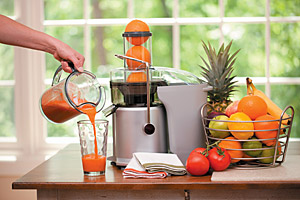We know the process of cooking vegetables destroys valuable micronutrients by altering their shape and chemical composition; but is it possible to eat enough raw vegetables to get the nutrition your body needs? That's where juicing can be valuable, particularly for developing children. Here's just some of the information on juicing you can share with parents.
The benefits of juicing are wide and varied, beginning with the fact that you can consume the most beneficial amounts of vegetables efficiently while absorbing all of the available nutrients. A habitually poor diet will eventually make your body less efficient at absorbing the maximum available nutrients in the foods you consume. By juicing vegetables, it's almost like they've been predigested, so you can receive the most nutrients available.
Additionally, we all know how difficult it can be to get children in particular to eat their vegetables; providing them in an easy-to-drink, flavorful juice can help with that problem. Another recommendation is to freeze the juice into popsicles. Although freezing the juice will damage some of the nutrients, the benefits (especially compared to the alternative – not eating any vegetables) are still really high.
Recommending the Right Juicer
 The first step for many families is buying a juicer. There are a numerous options, ranging in price from $100 to thousands of dollars. A high-quality juicer will be an extractor that extracts the flesh from the vegetables and then spins the juice out.
The first step for many families is buying a juicer. There are a numerous options, ranging in price from $100 to thousands of dollars. A high-quality juicer will be an extractor that extracts the flesh from the vegetables and then spins the juice out.
Clean-up time is an important consideration when it comes to juicing. Some machines will actually allow pulp to get into little nooks and crannies; if this happens, clean-up time is doubled and sometimes tripled because that pulp will rot if not removed and will require practically dismantling the machine to clean it. An extensive cleaning time could discourage you from juicing on a regular basis. A high-quality juicer should take no more than 5 minutes per use to clean.
The other consideration is speed. We all think faster is better; but when it comes to juicing, this is not the case. Inexpensive juicers are typically centrifugal and will spin at really high speeds to extract the juice. I do not recommend juicers that act more like blenders because the heat generated by the higher RPMs can actually damage the valuable nutrients, almost like cooking. Additionally, low-speed / single-gear machines will create a lot less foam, making the juice more palatable.
What to Juice?
After you've decided which juicer to purchase, the most important decision is what to actually put in the juicer. Things to consider: the greener the better; remember that fruit is high glycemic and can raise blood sugar; and never supplement your juice with bottled juice, as this defeats the purpose.
Encourage parents to buy organic fruits and veggies whenever possible, and to look for local farmers or co-ops that grow their products seasonally. Tell them not to be surprised at the amount of vegetables it is going to take to create one small glass of raw juice.
For those new to juicing, the best vegetables to start with are celery, fennel or cucumbers. These are easy to digest and tolerate. Once they've become accustomed to juicing, they can begin to add red-leaf, green-leaf or romaine lettuce, endive, escarole or spinach,and then cabbage or bok choy. Remember that cabbage can be a digestive irritant, so don't use too much at a time.
Adding herbs to your juicing can give you different flavors. Herbs to consider include parsley and cilantro. For a sweet, but low-glycemic flavor, consider adding lemons, limes, cranberries or fresh ginger.
To really boost the nutritional value of your juice, consider using kale or collard, dandelion or mustard greens; however, be aware that these are very bitter tasting, so only use two leaves and be sure to add one of the above natural sweeteners. Specifically, a quarter to a half of a lime with its rind will counteract some of that bitterness.
I don't recommend using oranges, as they are high glycemic, but if you choose to do so, do not juice the rinds, as they are typically high in absorbed pesticides. The same is true for grapefruit; although these are great to juice, do not use the rinds.
What Else Do Families Need to Know About Juicing?
Advise patients that there is essentially no protein and virtually no fat in vegetables. While this might sound great, this means that juicing cannot be a meal in and of itself, particularly for young children. So when drinking juice with a meal, be sure to always include a healthy protein option.
Cherie Colbom, author of the books Juicing for Life and Turbo Diet, has said that when she first started juicing, she felt worse before she felt better due to detox reactions. "You are going to be losing fat and when those fat cells are breaking down and all those toxins are getting released, you need a lot of antioxidants to get them out of your system and render them harmless. That's where juicing is just powerful." Although this may be more true for adults who've accumulated years of poor eating, parents still might want to start children off with a quarter cup of juice every other day, and monitor their energy and behavior after consuming their drink before increasing their intake.
Finally, parents should be taught that once they've juiced it, drink it. Once juiced, the nutrients in fruits and vegetables progressively begin to break down. Ideally, juice should be consumed within 12 hours of being made, but to truly take advantage of all that it offers, it really should be consumed immediately. The only way to properly store juice is using a vacuum sealing system. However, even using something like this only really allows you up to 24 hours.
Purees: The Quiet Way to Provide Healthy Veggies to Children
In the past few years, many young parents have returned to making their own baby food for their children. Selecting organic and seasonal vegetables and fruits for their infant, and then taking the time to prepare them, has become a very popular and often less expensive option for many households.
Recommend to parents that when they puree, they should start by steaming their favorite veggies until they can pierce them easily with a fork (usually after about 5 to 10 minutes, maximum). They can use a rice steamer or put a small amount of water in the bottom of a pan and put the veggies in a steamer basket on top of the pan.
After draining the vegetables, they should puree the item with a food processor or blender, and then store / freeze the puree in sealed baggies. They can then take wonderful veggies like cauliflower, broccoli, beets, butternut squash, zucchini and summer squash, sweet potatoes, spinach, red bell peppers and carrots and mix them into any meal, oftentimes without anyone even noticing. Placing a half cup of any puree in a meal may give their family the nutrients they are missing.
One retailer, Williams-Sonoma, now offers a BPA-free, 4-cup-capacity bowl with automatic steamer-blender and defroster. This same retailer also carries The Baby & Toddler Cookbook - Fresh Homemade Foods for a Healthy Start, which provides a variety of ideas for young parents. And Jessica Seinfeld, in her book, Deceptively Delicious, provides great ideas to take pureed vegetables and sneak them into everyday meals.
Americans young and old are suffering the health consequences of poor diets and low nutrient consumption. Bringing a variety of healthy nutrients to today's family meals may not always be easy, but chiropractors have a great opportunity to share ideas and encourage parents to choose a healthier path.
Click here for previous articles by Claudia Anrig, DC.





